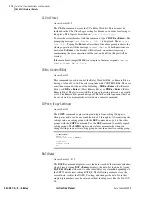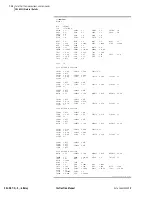
7.24
SEL-387-0, -5, -6 Relay
Instruction Manual
Date Code 20050919
Serial Port Communications and Commands
SEL ASCII Protocol Details
The two parameters are required:
➤
n
specifies the Access Level (1, B, or 2).
➤
newpas
specifies the new password.
Designate which access level password to change with the
n
= 1, B, or 2. The
new password designated by
newpas
can be up to six characters. The
following example changes the level one password to Ot3579. The passwords
are case sensitive.
=>>
PAS 1 Ot3579 <Enter>
Set
=>>
The relay sets the password, pulses the
ALARM
relay closed for approximately
one second, and transmits the response
Set
to the display.
Passwords can contain up to six characters and include any combination of
letters, numbers, periods, or hyphens. Upper- and lowercase letters are treated
as different characters. Strong passwords consist of six characters, with at
least one special character or digit and mixed case sensitivity, but do not form
a name, date, acronym, or word. Passwords formed in this manner are less
susceptible to password guessing and automated attacks. Examples of valid,
distinct strong passwords include:
Ot3579 A24.68 Ih2dcs 4u-Iwg .0387.
After entering new passwords, type
PAS <Enter>
to inspect them. Make sure
they are what you intended, and record the new passwords.
If the passwords are lost or you want to operate the relay completely without
password protection, install main board jumper JMP6A. With no password
protection, you can gain access without knowing the passwords, and view or
change active passwords and settings.
PUL n (Pulse)
Access Levels B, 2
The
PULSE
n k
command asserts the selected output contact
n
for
k
seconds.
The
k
parameter is optional. If
k
is not specified, the output contact is pulsed
for 1 second. Main board breaker jumper JMP6B must be in place. After
issuing the
PULSE
command, the relay asks for confirmation of the
operation, and then asks if you are sure. An invalid output contact name or
incorrect
k
value produces an error message.
Parameter
n
can be any existing output contact element name such as
OUT107
.
Parameter
k
must be a number ranging from 1 to 30 seconds.
=>>
PUL OUT107 3 <Enter>
Pulse contact OUT107 for 3 second(s) (Y/N) ?
Y <Enter>
Are you sure (Y/N) ?
Y <Enter>
=>>
QUI (Quit)
Access Levels 0, 1, B, 2
The
QUIT
command returns the relay to Access Level 0 from Level 1, B,
or 2. The command displays the relay settings RID, TID, date, and time of
QUIT
command execution.
NOTE:
If newpas is
DISABLE
(must be
uppercase), the password prompt and
password protection for the
n
level are
disabled. The relay responds with
Password Disabled
. This permits
the user to temporarily suspend
password protection, without
installing jumper JMP6A.
NOTE:
The
PUL
command is useful
during testing to verify operation of
output contacts, but it should not be
used while the relay is in service.
During the entire time the specified
output contact is being pulsed, all
other output contacts are frozen in
their existing state and are not
permitted to change. This could
prevent a trip or other critical output
from being issued during the specified
PUL time interval.
Summary of Contents for SEL-387-0
Page 10: ...This page intentionally left blank ...
Page 16: ...This page intentionally left blank ...
Page 56: ...This page intentionally left blank ...
Page 350: ...This page intentionally left blank ...
Page 388: ...This page intentionally left blank ...
Page 456: ...This page intentionally left blank ...
Page 494: ...This page intentionally left blank ...
Page 528: ...This page intentionally left blank ...
















































